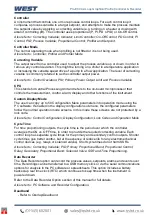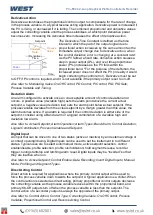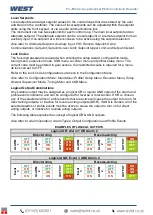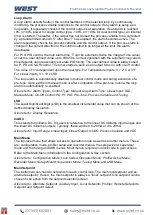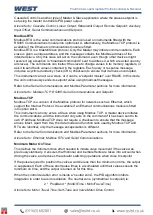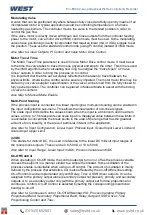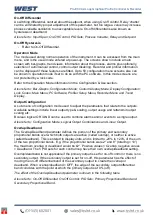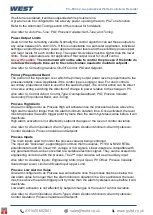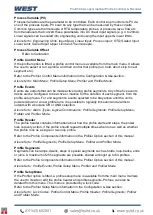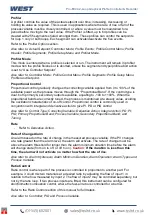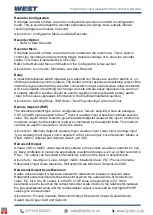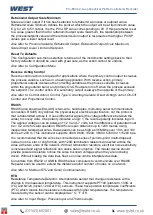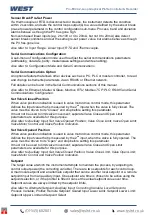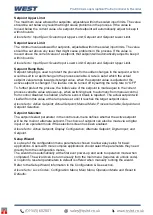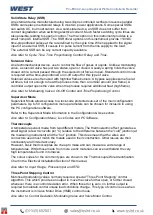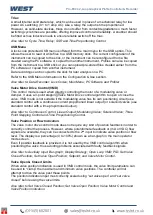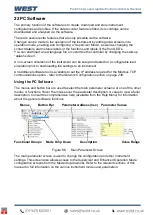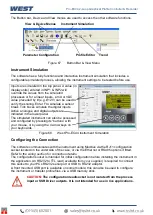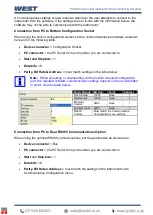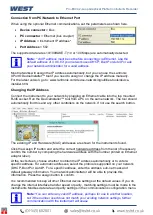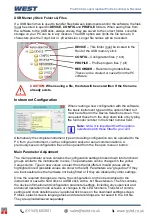
Pro-EC44 2-Loop Graphical Profile Controller & Recorder
Pro-EC44 Product Manual - 59540-2 September 2014
Page 224
If self-tune is enabled, it will be suspended while pre-tune runs.
A pre-tune can be configured to run at every power up using the Auto Pre-Tune function.
Refer to the Automatic Tuning section of this manual for full details.
Also refer to: Auto Pre-Tune; PID; Process Variable; Self-Tune; and Tuning.
Power Output Limits
Used to limit the correcting variable. Normally the control algorithm can set these outputs to
any value between 0% and 100%. If this is undesirable in a particular application, individual
settings can limit the primary power upper and lower levels and the secondary power upper
and lower levels for each control loop. The upper limit values must be higher than the lower
limits. These parameters are not applicable if that output is set for on-off control.
Use with caution:
The instrument will not be able to control the process if the limits do
not allow the outputs to be set to the correct values needed to maintain setpoint.
Also refer to: Correcting Variable; On-Off Control; PID and Setpoint.
Primary Proportional Band
The portion of the input span over which the primary output power level is proportional to the
process variable value. Applicable if the control type is single or dual. For dual control a
secondary proportional band is used for the second output. The control action can be direct
or reverse acting, switching the direction of change in power relative to the change in PV.
Also refer to: Control Action; Control Type; Overlap/Deadband; PID; Process Variable;
Secondary Proportional Band; and Tuning.
Process High Alarm
An alarm configured to as Process High will activate once the process has been above the
high alarm value for longer than the alarm minimum duration time. Once activated, the level
must drop below the alarm trigger point by more than the alarm hysteresis value before it will
deactivate.
High alarm activation is not affected by setpoint changes or the level of control deviation.
Also refer to: Alarm Operation; Alarm Types; Alarm Duration Minimum; Alarm Hysteresis;
Control Deviation; Process Variable and Setpoint.
Process Inputs
The main inputs used to monitor the process value(s) being controlled.
The input are
“Universal”, supporting all common thermocouples, PT100 & NI120 RTDs,
potentiometers and DC linear mV, voltage or mA signals. Linear inputs are compatible with
any parameter that can be converted to a suitable electronic signal. They can be scaled into
engineering units to match the process. The 2
nd
input can also act as an auxiliary input.
Also refer to: Auxiliary Inputs; Engineering Units; Input Span; PV Offset; Process Variable;
Scaled Input Lower Limit and Scaled Input Upper Limit.
Process Low Alarm
n
Value
An alarm configured to as Process Low will activate once the process has been below the
low alarm value for longer than the alarm minimum duration time. Once activated, the level
must rise above the alarm trigger point by more than the alarm hysteresis value before it will
deactivate.
Low alarm activation is not affected by setpoint changes or the level of control deviation.
Also refer to: Alarm Operation; Alarm Types; Alarm Duration Minimum; Alarm Hysteresis;
Control Deviation; Process Variable and Setpoint.
Summary of Contents for Pro-EC44
Page 1: ...Pro EC44 2 Loop Graphical Profile Controller Recorder Pro EC44 User Guide 59540 2 ...
Page 2: ......
Page 6: ......


